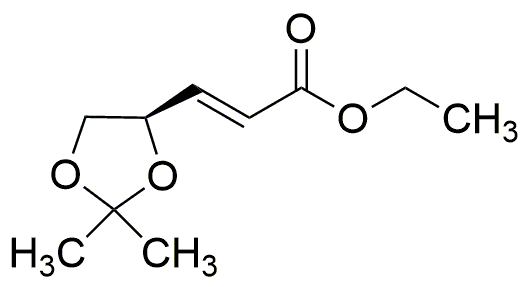Ethyl (R)-(-)-3-(2,2-dimethyl-1,3-dioxolan-4-yl)-trans-2-propenoate is widely utilized in research focused on:
- Pharmaceutical Development: This compound serves as a key intermediate in the synthesis of various pharmaceuticals, particularly in the development of drugs that target specific biological pathways.
- Agricultural Chemistry: It is used in formulating agrochemicals, enhancing the efficacy of pesticides and herbicides, which helps in improving crop yields and protecting plants from pests.
- Flavor and Fragrance Industry: The compound is employed in creating unique flavor profiles and fragrances, making it valuable in food and cosmetic products.
- Polymer Science: It acts as a monomer in the production of specialty polymers, which are used in coatings, adhesives, and sealants, providing enhanced durability and performance.
- Research and Development: This chemical is a useful reagent in organic synthesis, allowing researchers to explore new chemical reactions and develop innovative materials.
General Information
Properties
Safety and Regulations
Applications
Ethyl (R)-(-)-3-(2,2-dimethyl-1,3-dioxolan-4-yl)-trans-2-propenoate is widely utilized in research focused on:
- Pharmaceutical Development: This compound serves as a key intermediate in the synthesis of various pharmaceuticals, particularly in the development of drugs that target specific biological pathways.
- Agricultural Chemistry: It is used in formulating agrochemicals, enhancing the efficacy of pesticides and herbicides, which helps in improving crop yields and protecting plants from pests.
- Flavor and Fragrance Industry: The compound is employed in creating unique flavor profiles and fragrances, making it valuable in food and cosmetic products.
- Polymer Science: It acts as a monomer in the production of specialty polymers, which are used in coatings, adhesives, and sealants, providing enhanced durability and performance.
- Research and Development: This chemical is a useful reagent in organic synthesis, allowing researchers to explore new chemical reactions and develop innovative materials.
Documents
Safety Data Sheets (SDS)
The SDS provides comprehensive safety information on handling, storage, and disposal of the product.
Product Specification (PS)
The PS provides a comprehensive breakdown of the product’s properties, including chemical composition, physical state, purity, and storage requirements. It also details acceptable quality ranges and the product's intended applications.
Certificates of Analysis (COA)
Search for Certificates of Analysis (COA) by entering the products Lot Number. Lot and Batch Numbers can be found on a product’s label following the words ‘Lot’ or ‘Batch’.
*Catalog Number
*Lot Number
Certificates Of Origin (COO)
This COO confirms the country where the product was manufactured, and also details the materials and components used in it and whether it is derived from natural, synthetic, or other specific sources. This certificate may be required for customs, trade, and regulatory compliance.
*Catalog Number
*Lot Number
Safety Data Sheets (SDS)
The SDS provides comprehensive safety information on handling, storage, and disposal of the product.
DownloadProduct Specification (PS)
The PS provides a comprehensive breakdown of the product’s properties, including chemical composition, physical state, purity, and storage requirements. It also details acceptable quality ranges and the product's intended applications.
DownloadCertificates of Analysis (COA)
Search for Certificates of Analysis (COA) by entering the products Lot Number. Lot and Batch Numbers can be found on a product’s label following the words ‘Lot’ or ‘Batch’.
*Catalog Number
*Lot Number
Certificates Of Origin (COO)
This COO confirms the country where the product was manufactured, and also details the materials and components used in it and whether it is derived from natural, synthetic, or other specific sources. This certificate may be required for customs, trade, and regulatory compliance.


